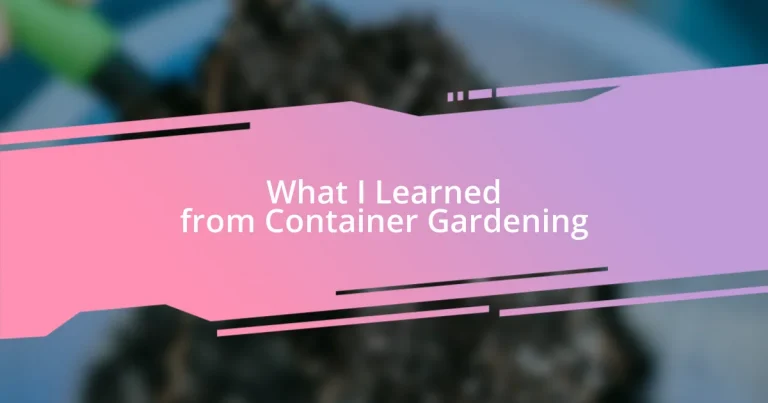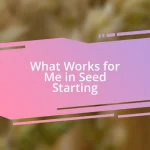Key takeaways:
- Choosing the right containers with proper drainage and suitable materials is essential for plant health and growth.
- Selecting the appropriate soil mix, tailored to the specific needs of each plant, significantly affects their overall health and productivity.
- Effective pest management strategies, such as companion planting and introducing beneficial insects, can enhance container gardening success.
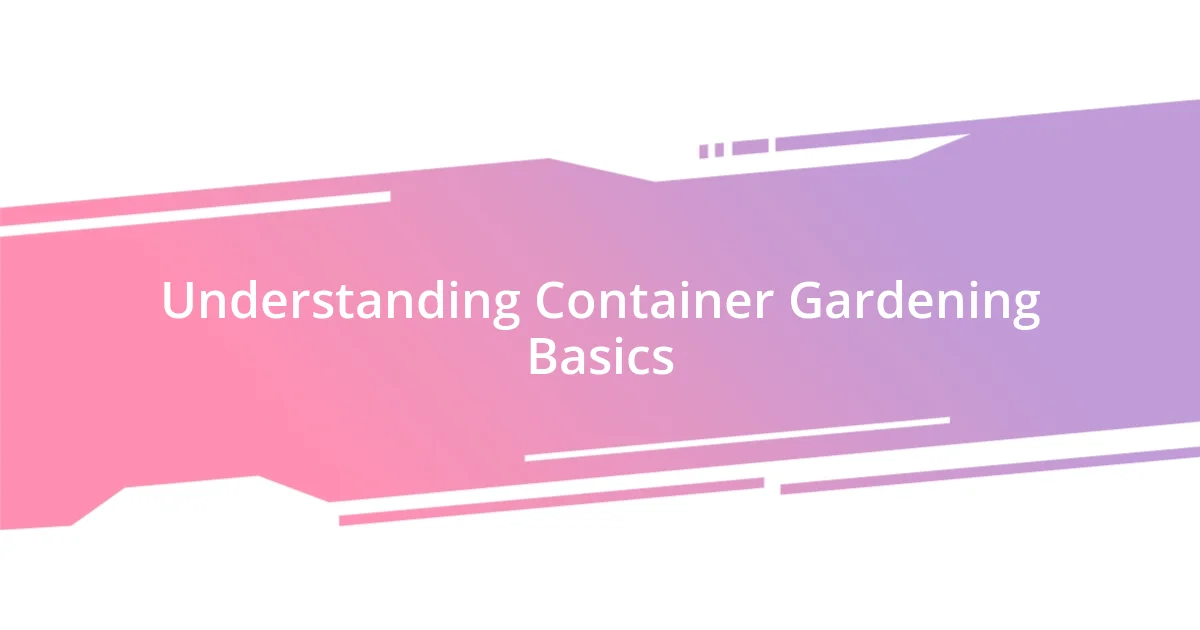
Understanding Container Gardening Basics
Container gardening is truly a wonderful way to cultivate plants, especially if you’re tight on space or want to add some greenery indoors. I remember when I first started, I was surprised at how simple it was to use pots and planters instead of traditional garden beds. Have you ever thought about how portable gardening can transform not just a patio, but your entire living space?
Choosing the right containers is crucial, and it’s fascinating to see the variety out there, from terracotta pots to fabric bags. I learned the hard way that not all materials are created equal; some can retain too much moisture and cause root rot, which was a lesson I won’t forget! Isn’t it rewarding when you find that perfect pot that balances aesthetics and practicality?
One key aspect to consider is drainage. I’ll never forget the time I neglected to put holes in the bottom of a charming clay pot. The disappointment of losing my young basil plants was a real eye-opener. Why is understanding drainage so important, you ask? Without it, your plants can drown, ultimately stunting their growth. It’s a fundamental concept, yet one that can significantly impact your gardening success.
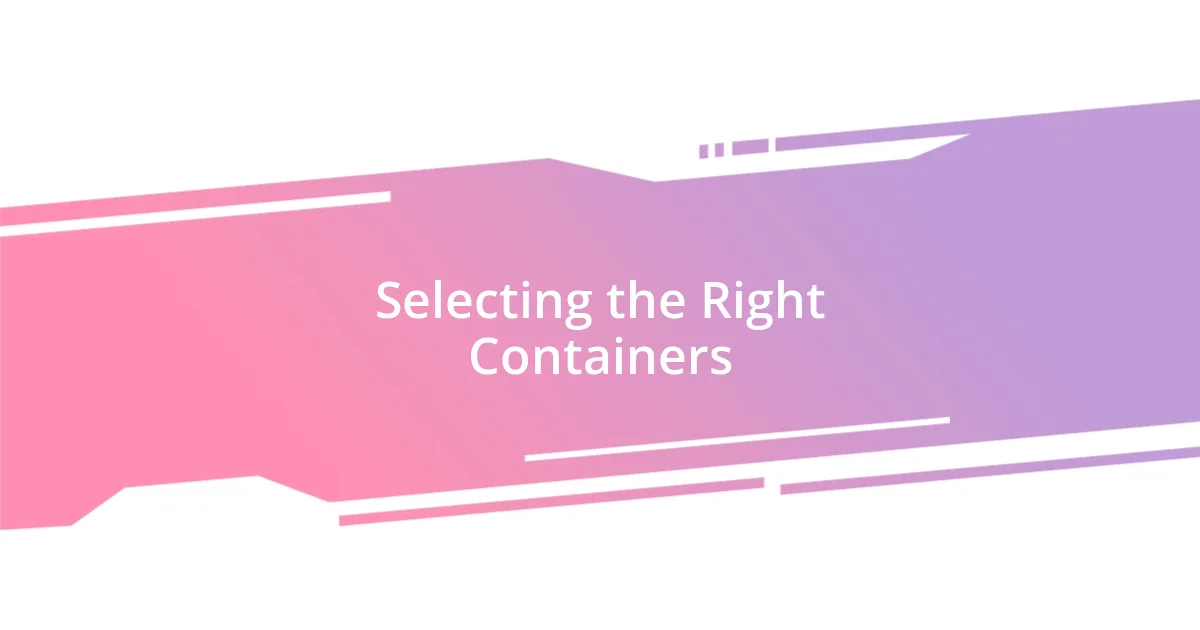
Selecting the Right Containers
Selecting the right containers can feel a bit overwhelming due to the myriad of options available, but my experience has taught me to prioritize practicality alongside aesthetics. When I first started, I was drawn to the appearance of brightly colored pots, only to discover that materials like plastic can heat up quickly in the sun, affecting plant health. Now, I consider the needs of the plants first, ensuring that the container supports their growth while complementing my space.
Here are some key things I keep in mind when selecting containers:
- Material: Choose breathable materials like clay or wood for better air circulation, but be cautious of their weight if you plan to move them often.
- Size: Ensure the container is large enough to allow for root expansion; I once used a too-small pot for my tomato plant, and it stunted its growth.
- Drainage: Opt for containers with drainage holes; it’s invaluable for preventing waterlogging.
- Style: Consider how the container fits into your overall aesthetic; I love using simple, elegant pots that blend seamlessly with my home décor.
- Portability: If you plan to relocate your plants, lightweight containers can save you time and effort.
Reflecting on these factors has not only improved my gardening success but also enhanced the joy I find in nurturing my plants.
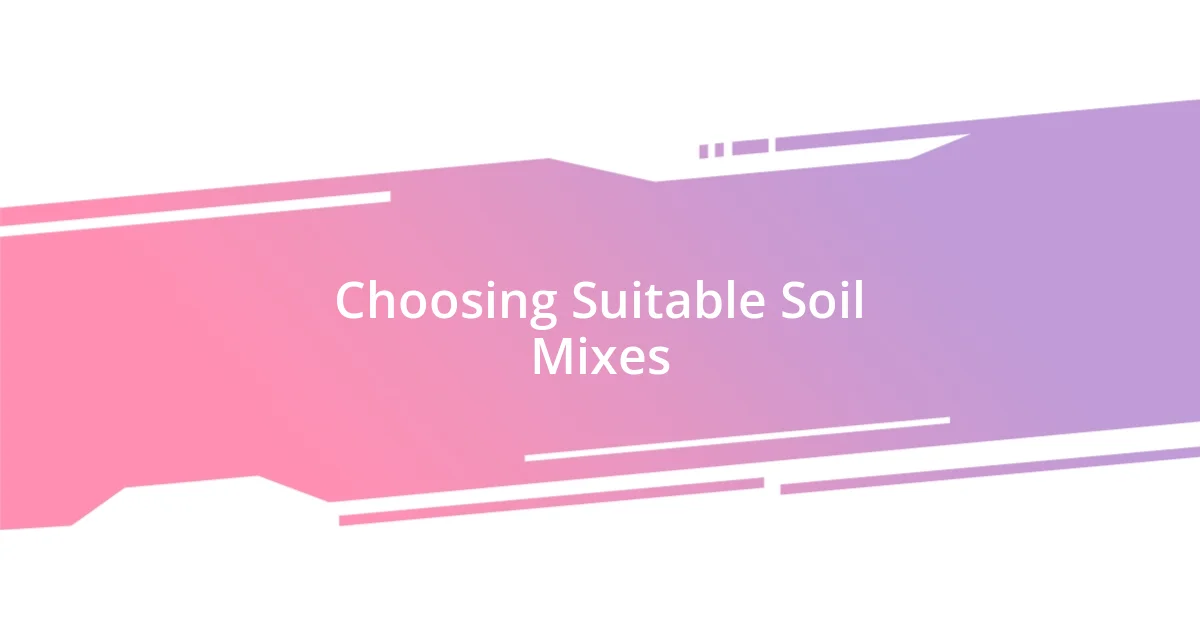
Choosing Suitable Soil Mixes
Choosing the right soil mix for your container garden is just as vital as selecting the containers themselves. From my experience, a quality soil mix will provide the necessary nutrients while ensuring proper drainage and aeration. I remember when I first used an all-purpose potting mix—I found out the hard way that it was too dense for my delicate seedlings, and they ended up struggling. To avoid such pitfalls, I now look for a mix that incorporates organic matter, like compost or peat moss, which helps retain moisture without becoming waterlogged.
It’s essential to consider the specific needs of each plant when choosing a soil mix. For instance, when I planted succulents, I discovered that a gritty, fast-draining mix worked wonders. I was amazed at how quickly they thrived compared to when I tried using the same potting mix as my herbs. Tailoring the soil to your plant’s requirements can drastically impact its growth and overall health. How about you? Have you found a specific mix that works best for your plants?
I’ve also learned the importance of fertilizing my soil mix. When I neglected this step, I noticed my basil didn’t grow as robustly as it should have. Now, I always make sure to incorporate slow-release fertilizers into my soil mix. This way, I ensure my plants receive the nutrients they need throughout their growth cycle, ultimately leading to a bounteous harvest. Isn’t it fascinating how the right soil mix can make such a difference in the gardening experience?
| Soil Mix Type | Best Use |
|---|---|
| All-Purpose Potting Mix | General use for most container plants, but ensure it’s light and well-draining |
| Succulent Mix | Perfect for succulents and cacti; contains more sand or perlite for drainage |
| Seed Starting Mix | Ideal for germinating seeds; very fine and light for young roots |
| Herb Mix | Balanced nutrients designed specifically for herb growth, often includes organic matter |
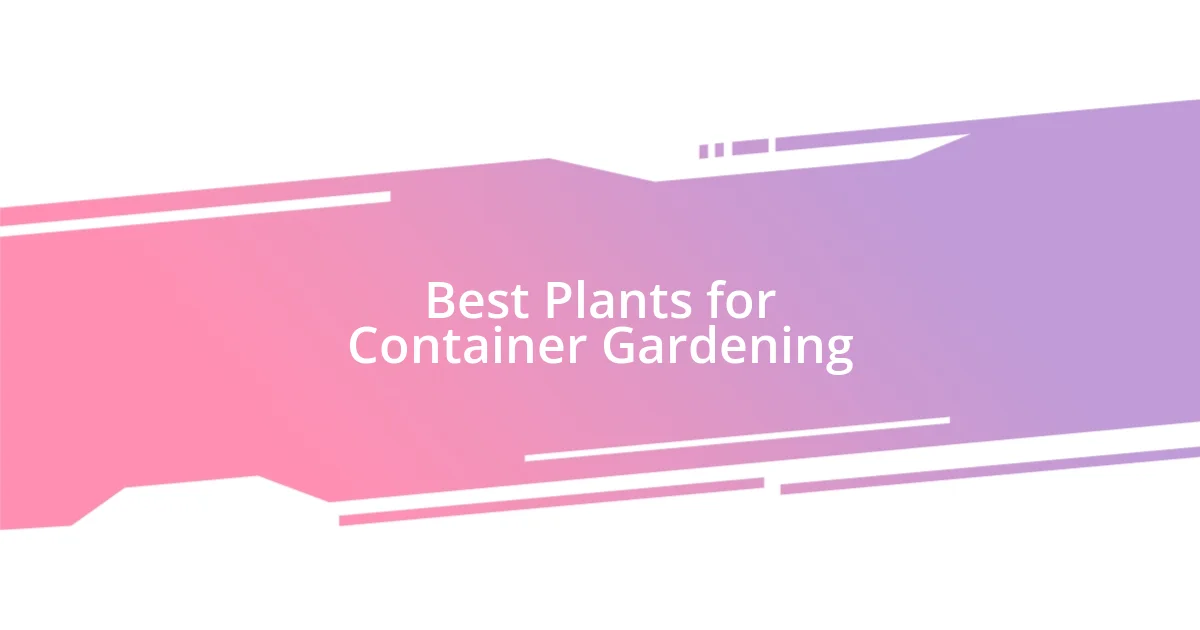
Best Plants for Container Gardening
When it comes to choosing the best plants for container gardening, I’ve discovered that herbs are some of the most rewarding options. The first time I planted basil in a sunny window box, I was astounded by how quickly it flourished. Being able to snip fresh basil for my pasta dishes just a few weeks later was not only exhilarating but really deepened my appreciation for home gardening. Have you ever tasted a homegrown herb? The difference is like night and day!
Vegetables are also a fantastic choice for container gardening, especially varieties like tomatoes and peppers. I’ll never forget the thrill of harvesting my first cherry tomatoes—each one was a burst of flavor that left me wanting more. The key is to choose dwarf or compact varieties, which thrive even in smaller pots. What’s been your biggest harvest success?
You also shouldn’t overlook flowers, as they add a splash of color and vibrancy to your space. I once filled a couple of containers with petunias and marigolds, and it transformed my patio into a little oasis. Their cheerful blooms lifted my mood and provided a delightful backdrop for every summer gathering. Isn’t it incredible how the right plants can change not just your garden, but your entire outlook at home?
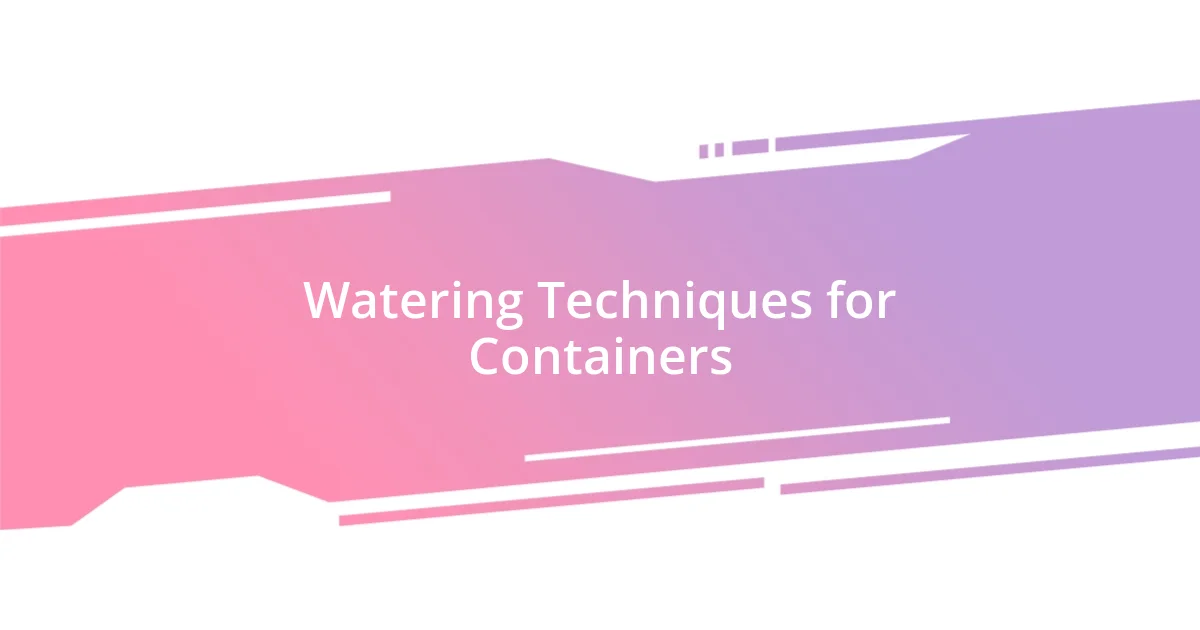
Watering Techniques for Containers
Watering container plants can feel like an art form once you develop your technique. I remember one summer when I overwatered my petunias; the poor things looked droopy, and I panicked. After some research, I learned that container plants typically need watering more frequently, especially during hot weather, but the key is to water deeply and infrequently. This encourages the roots to grow deeper in search of moisture, making plants healthier and more resilient.
I’ve found that using self-watering pots can be a game changer, especially for someone with a busy schedule like mine. These pots come with a reservoir that allows plants to absorb water as needed, reducing stress for both the plant and myself. I can recall how amazed I was to see my herbs thriving while I was away for a weekend trip, thanks to this simple innovation. Have you ever tried self-watering pots? They can truly ease the burden of regular watering.
Don’t forget about the method you use to-water. I prefer using a watering can with a narrow spout to avoid splashing soil everywhere, which I learned the hard way after a messy gardening session! Gently watering at the base of the plant rather than from above helps prevent fungal issues and ensures the moisture goes directly to the roots. Have you experienced similar challenges? A simple tweak in technique can enhance your container gardening results significantly.
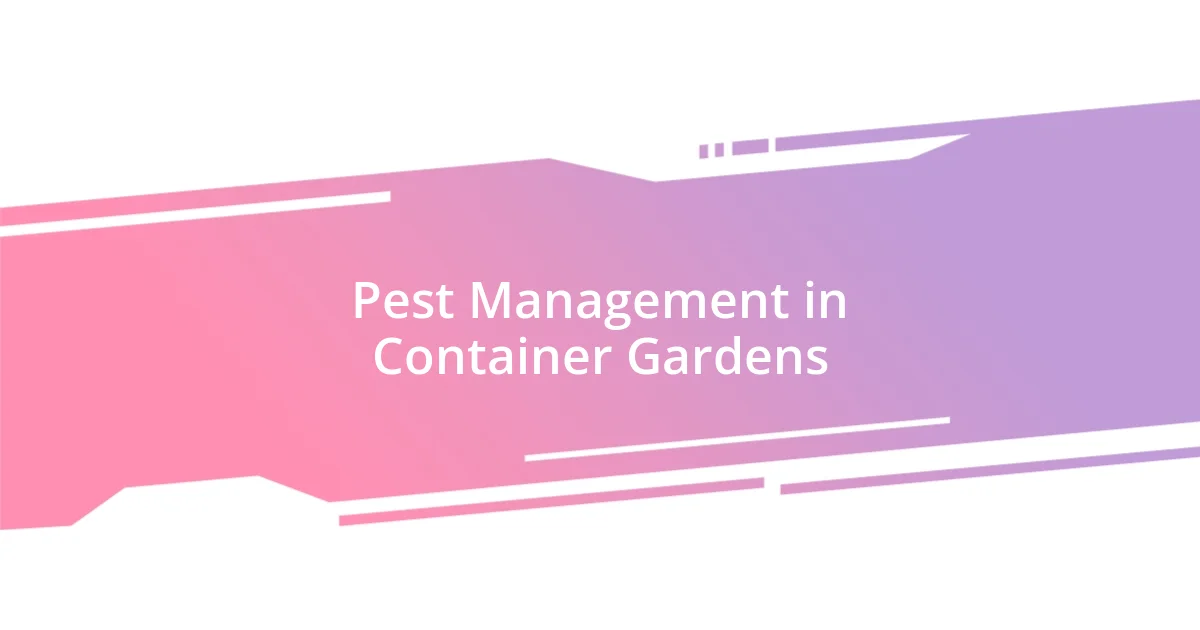
Pest Management in Container Gardens
Managing pests in container gardens can be a bit tricky, but I’ve learned some effective strategies along the way. For me, a close inspection of my plants became a habit. I remember when aphids snuck onto my beloved tomato plants. I was shocked to find them feasting on the tender leaves! But after addressing them with a gentle spray of soap and water, I was relieved to see my tomatoes bounce back to health. Have you had a similar pest scare?
I also experimented with companion planting, which turned out to be a delightful discovery. Planting marigolds next to my veggies not only brightened my garden but also kept those pesky nematodes at bay. It felt like a gardening secret that I was excited to share! Have you tried this approach? Sometimes, nature has its own way of providing a pest control solution, and it can be incredibly rewarding to witness.
Another tactic that has proven invaluable for me is introducing beneficial insects. Ladybugs are like tiny superheroes in the garden! When I released a few in my container garden, it felt triumphant as they devoured the pests threatening my plants. Watching these little helpers go to work made me realize how important it is to maintain a natural balance. Have you ever considered enlisting nature in your pest management? It’s a beautiful reminder that sometimes the best solutions are right under our noses.
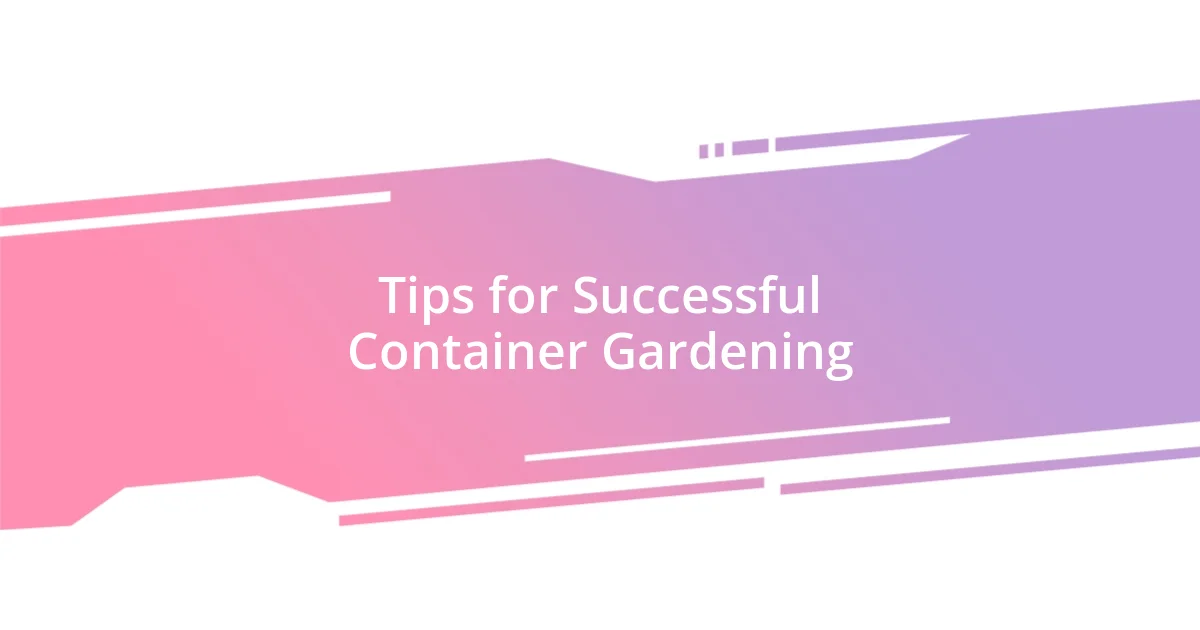
Tips for Successful Container Gardening
When it comes to choosing the right container for your plants, size truly matters. I vividly remember my first attempt at container gardening, where I picked beautiful but small pots for my tomatoes, thinking they’d look charming on my patio. To my dismay, the plants outgrew their homes within weeks! Now, I always opt for larger containers, allowing ample space for roots to spread and flourish. Have you ever faced similar frustrations with container size? It’s a lesson learned; bigger really is better in this case.
Drainage holes at the bottom of your containers are non-negotiable. One summer, I neglected to drill these openings in a couple of pots, hoping they’d retain moisture longer. Unfortunately, my plants drowned! Now, I make it a point to ensure every container is equipped for proper drainage to prevent waterlogging. Do you prioritize drainage in your gardening? Trust me, it’s essential for healthier plants and can save you a lot of heartache.
Finally, don’t underestimate the power of adding fertilizers. My first few crops suffered from nutrient deficiencies because I assumed my potting mix had everything they needed. After experimenting with organic fertilizers, I was amazed by the transformation in growth and color. If you’ve noticed stunted plants or yellowing leaves, consider a nutrient boost. What has been your experience with plant nutrition? It can dramatically impact the vibrancy and yield of your container garden!












